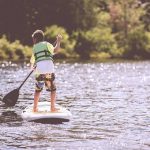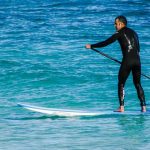One can derive a great deal of relaxation and therapeutic benefit from partaking in paddle boarding, the fun water sport, which is also beneficial for one’s physical health.
Unnecessary elements can be hazardous, and errors in paddle boarding can lead to fatalities. Getting informed on the best practices for safe water activity will stop you from making rookie mistakes that could cause harm.
The risks of stand-up paddleboarding include not having sufficient swimming ability, venturing out into rough weather or shallow, rocky regions, and going for a paddle unaccompanied.
Neglecting to wear flotation devices, failing to comprehend how to work the paddle, and not having the proper gear size are contributing elements too.
The sports activity known as stand-up paddle boarding has become extremely fashionable in the last few years and is now one of the most popular aquatic sports globally. The surge in interest means that many novice paddlers will be out on the water, so it’s important for you to learn as much as you can beforehand.
It is imperative to take necessary safety measures in order to ensure that everyone involved is safe and can make the most of their experience.
7 Dangers of Paddle Boarding
If you are unfamiliar with what paddle boarding is, look up an image online. People at the beach can be seen standing on a surfboard and paddling forward, as they glide through the air. It’s basically kayaking while standing up.
It is essential to keep in mind that the Coast Guard defines what is regulated in terms of whether one is operating a watercraft during paddle boarding.
The Guard views a paddleboard as a vessel when it is being used for either swimming or surfing. In the event that the specific watercraft is labeled for uses other than swimming, surfing, or bathing, then the Coast Guard will no longer regard it as a boat.
This translates to you needing to use the same safety measures while navigating on your stand-up paddleboard as you would while using any other type of watercraft; that being wearing a life jacket.
#1 Not Wearing a Life Jacket
It is absolutely essential that you wear a life jacket while engaging in water sports such as paddle boarding, as this is an utterly essential precaution to take. This applies to paddlers with a lot of experience as well as those who are new to the sport.
Life jackets may not be the most comfortable item to put on, but it is the simplest way to safeguard yourself whilst out on the water.
Not wearing a life vest could potentially be fatal. Although this sounds dramatic, it’s absolutely true. And this isn’t to insult your swimming skills.
Putting on a seat belt is well worth the small effort involved. In the United States Coast Guard’s yearly report on leisure boating activities, it was revealed that in 2017, 658 people died and 2,629 were injured while out on the water.
#2 Not Understanding Weather Conditions Properly
If you want to consider yourself an expert in stand-up paddle boarding, you must be able to interpret the weather and figure out if the water is suitable that day.
It is a serious error to venture out into hazardous conditions, and it should be perceived for what it is – an amateurish error. Many paddleboarders are confident about their abilities and willing to take on rough seas or unfavorable surroundings.
Making the wrong move could easily lead to being smashed by the rocks and drowning in a catastrophic manner. Mother Nature is more powerful than you, and the initial step you should take to becoming a more secure stand up paddle boarder is realizing that she will not show you any leniency.
Through the course of history, the sea has taken countless human and animal lives, hiding away innumerable mysteries and sunken ships. It has no problem taking you under too.
#3 Not Having Properly Fitted Equipment
This is an essential matter that may not appear to be of great importance. Making sure your equipment fits you correctly can drastically improve your coordination and increase your likelihood of having an enjoyable paddle boarding experience.
If you do not possess the suitable apparatus or it does not fit your stature and frame, you will not have an enjoyable or effortless experience as possible.
You will need to consider what your particular usage of the board is and how you would like it to perform out on the water in order to choose the right board.
#4 Not Holding the Paddle Correctly
If you have been mishandling the paddle or ore, you will experience more discomfort after your surfing session than is necessary. If boarding feels awkward or not quite right, there’s a chance you may be performing the task incorrectly.
This blunder should be addressed by every novice if they want to remain in the activity with no agony. Having the right grip on your paddle will feel like second nature and lead to a more uninterrupted rowing motion as well as a faster glide on the water.
#5 Not Knowing How to Swim
It is absolutely necessary to take safety precautions when paddle boarding, and doing so is of the utmost importance. In order to be on the water, it is essential to have a rudimentary knowledge and capability for swimming comfortably.
Having the ability to swim proficiently may be the deciding factor between staying alive or not during dangerous sporting activities. This will give you the skills to be able to stay above water if you are ever knocked off your board or you fall in, which is referred to as “Self-rescue.”
#6 Not Paddle Boarding with a Group
It is not advisable to try any water sports activities without assistance. Going out on a paddle board at night can seem like a thrilling solo adventure, but it is important to remember that many accidents and fatalities occur due to individuals exploring by themselves as opposed to going out with a buddy or in a group.
Unfortunately, tragedies such as people getting lost, hurt, or drowning can be prevented if you are a sensible sportsperson.
#7 Not Being Ready to Paddle in Shallow Waters
This is rather intimidating due to the risk you could face by going into shallow waters such as getting ensnared by coral reefs, facing sea creatures, stumbling onto rocks, or even finding yourself within an oyster bed.
If you’re paddle boarding in a body of water with shallow depths, you must be vigilant and ensure that you’re following safety protocols. Even if that means paddling slowly.
A man suffered excruciating injuries when his paddle board slipped out of his grasp and he tumbled into an oyster bed. You run the danger of being cut to ribbons should you venture into a coral reef, faster than if a shark was taking bites out of you.
A GUIDE TO SUP SAFETY
1. PADDLE BOARD SAFETY GEAR
SUP LEASH
A leash is the most crucial element for ensuring safety when using a stand up paddle board. Whether you are a complete novice or an experienced paddle boarder, this particular piece of gear can be the dividing line between life and death.
A leash attaches you to your board, acting as a lifeline in case your floatation device gets swept away in a matter of moments. The use of a leash ensures that not just your life, but the safety of those around you is being taken care of.
The ideal length of leash to be used when paddle boarding is one foot longer than the board. What the exact type of leash should be depends on the conditions in which you are paddle boarding.
If you are someone who goes paddling in the ocean, using a straight leash would be the best option. This kind of leash brings security without the possible jerk and knot that could happen in rough rapids.
If you’re doing flat water paddle boarding, the tightly wound leash will be your companion since it will stay at the surface of your board and not get pulled under by the water and impede your progress. For river paddlers, wearing a breakaway leash or a quick release leash is a must.
This is to prevent the paddler from being dragged underwater should they end up tangled in branches.
SUP PFD
The next most critical item for stand up paddle board security is a lifejacket, also known as a PFD (Personal Flotation Device). If you are operating a standup paddleboard, it is technically considered a vessel when you venture beyond the boundaries of the area typically reserved for swimming, surfing, or bathing.
It is legally mandated to don a United States Coast Guard compliant flotation device when going beyond the established “swimming, surfing, or bathing area” in these waters. To ensure your safety, opt for a life jacket that provides optimal buoyancy.
Even while swimming in the areas designated for surfing and swimming, a surfboard can drift off quickly and attempting to keep up with paddling is sure to cause extreme fatigue.
2. WHAT TO MONITOR BEFORE PADDLE BOARDING
It appears to be easy to do, but standup paddleboarding actually requires technical skill and alertness to the fluctuating forces of nature which may bring risks.
WIND
It is essential to be mindful of the wind before going out for a paddle, as it is the foremost meteorological factor. Fast winds create intense waves that can be hazardous for those not well-versed in paddling.
When the wind is blowing hard, it can be difficult to maintain your equilibrium in the water rather than successfully swimming to your intended destination. Consequently, it is significant to look up the wind prediction prior to beginning your paddle.
Generally speaking, it is generally safe for anyone of any skill level to paddle out when the wind is blowing at a speed of less than 10 knots. However, if the wind is blowing more than 10 knots (which is uncommon in San Diego but can happen elsewhere), you should think carefully before going out paddling.
You should observe the direction of the wind while paddling out during your paddleboard session. If you experience a draught of wind when you begin your paddle, you should pivot and paddle upwind, as that will make it easier when you go back to the shore.
SWELL
Waves become bigger and the seas get rougher when swells hit. One should never underestimate the strength of water since big wave heights can result in getting thrown around while paddling.
Although you may feel competent in venturing out into the tranquil ocean, the waves can bring an entire new layer of difficulty that necessitates more physical effort than usual.
It is important to be aware of your physical strength and the path of paddling when navigating new, larger waves that are different from the surf you are accustomed to at your nearby shore.
TIDES
It is essential to have the essentials of tide knowledge and its origins for competent navigation on your paddle board across the ocean. Being aware of the effect of the tides can help you progress quickly due to the powerful nature of the current.
It will take you longer to paddle back to shore than it did to paddle out, so it’s important to factor this into your planning beforehand, or it could be a tiring journey.
Thus, it is essential to chart your course to reflect the current of the tides to make certain your journey ends with a safe return to the beach and that you don’t become fatigued.
SUNRISE / SUNSET
It is essential to be aware of when the sun rises and sets to avoid paddling in the dark. Understanding when the sun will come up and go down can be useful in structuring your kayaking plan so you never set out too early in the darkness and also make sure you get to shore prior to sunset.
3. DIFFERENT TERRAINS OF paddle boarding
SURF
When SUP surfing, it is important to thoughtfully take into account the people nearby. Understand your proficiency before you surf among those who are more experienced than you. Act humbly and don’t overestimate your abilities.
The lineup is known as the “impact zone” due to the increased risk of a possible crash. Novices ought not venture into an overcrowded area of the ocean that is full of surfers and boogie boarders, as the development of surfing abilities is a product of experience.
To make paddling out simpler, you should try to find the path that requires the least effort; this can be a rip current that will help you reach the line-up or a waterway. Be respectful to other SUP surfers and if you’re new to the sport, make sure to give more experienced surfers plenty of room.
RIVER
It can be an enjoyable activity for paddle boarders to ride the waves of a river, though it can also be hazardous as you may become stuck in underwater tree branches and succumb to its current.
Keeping close to your paddleboard, your most significant flotation device, is the best way to prevent yourself from being pulled underwater or dragged away. Utilizing your detachable leash is essential to make sure this doesn’t happen.
TOURING
Stand up paddleboards created for travelling long distances are available. It is essential to maintain humility and be aware of your capabilities with regard to these. If you are inexperienced, it is not a good idea to try a long-distance paddling race, and it is essential to ask other people where is it safe to paddle.
It is also important to be defensive. Abide by the regulations, which means you should not paddle in inappropriate areas and steer clear of other swimmers, riders with boards and other paddle boarders.
in conclusion
In conclusion, paddle boarding can be a fun and rewarding activity, but it’s essential to prioritize safety while on the water.
By following the guidelines and tips outlined in this article, you can minimize the risks associated with paddle boarding and enjoy a safe and enjoyable experience.
Remember to always wear a properly fitting life jacket, stay within your skill level and physical abilities, be aware of your surroundings, and be prepared for changes in weather and water conditions.
Additionally, it’s a good idea to take a paddle boarding safety course and invest in quality equipment to ensure you have the best possible experience.
By making safety a top priority, you can fully enjoy the benefits of paddle boarding and create unforgettable memories on the water. Stay safe and happy paddling!




